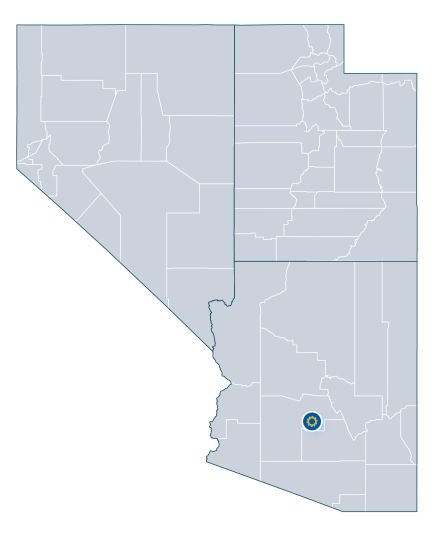The NSF Southwest Sustainability Innovation Engine (SWSIE), led by Arizona State University, is building a long-term foundation for economic prosperity and a regional innovation ecosystem to address water scarcity, energy security and air quality in the Southwest United States.
Addressing a critical U.S. need: The Southwest region, which comprises Arizona, Nevada and Utah, is vulnerable due to extreme aridity and heat coupled with rapid population growth. Within the next 10 years, temperatures may frequently exceed 120 degrees Fahrenheit and drought conditions will likely be more severe. The scale of the challenges in the American Southwest demands a coordinated approach to regional innovation that transcends state boundaries. By uniting academic, community, nonprofit and industry partners across Arizona, Nevada and Utah, the NSF SWSIE Engine drives an economic development strategy with solutions to air quality, water scarcity and energy security. Innovation in these domains enables regional industries in the Southwest that are critical to the global economy and national security, like semiconductor manufacturing, aerospace and defense and mining.
Year 1 impacts:
- Accelerating innovation: An NSF SWSIE Engine-backed long-duration energy storage (LDES) project is creating the nation's largest non-lithium battery energy pilot. Led by Salt River Project (SRP) — one of Arizona's oldest and largest public utilities — the Desert Blume LDES installation will deliver 5 megawatts of 10-hour-duration grid storage. SRP's investment in LDES signals a major step forward in securing reliable, sustainable energy for Arizona.
- Attracting local investment: The NSF Engine partners have generated more than $20 million in private, philanthropic and government contributions to fuel SWSIE projects in the first year, with a pipeline of over $100 million for the second year.
- Building partnerships: The NSF Engine’s partner roster now numbers more than 150 companies and organizations. Partners include academic, community, government and industry stakeholders — including some of the nation's largest technology companies like NVIDIA and Intel. New collaborations are connecting leaders in water and power infrastructure and emerging tech with policymakers, educators and investors, who work together to bolster growth and opportunity while safeguarding the region's economic vitality.
- Expanding and training the future workforce: Recognizing that technology adoption requires a skilled labor force, the NSF SWSIE Engine is helping build workforce pipelines that integrate technical training, apprenticeships and upskilling programs to prepare workers for careers in emerging industries. The Engine established an education and training programs database that catalogs education and training programs across Arizona, Nevada and Utah in the air quality, energy security and water scarcity sectors. The database contains an inventory of programs offered by community colleges, public and private universities, technical schools and union programs — a total of 512 programs in Utah, 470 in Arizona and 694 in Nevada. Program types include apprenticeships, certificates, associates and four-plus year degrees. In preparation for Desert Blume going online in December 2025, the SWSIE Engine worked with its core partner Maricopa Community Colleges to develop an LDES Technician Training program — including online education modules for the region's community colleges and universities — to support the pilot site by June 2025.
- Growing the local economy: The NSF SWSIE Engine backed a startup, WAVR, from the University of Nevada, Las Vegas to develop devices that capture water vapor from the air for commercial and industrial use. WAVR's atmospheric water harvesting (AWH) technology captures over five times more water than existing technologies and is effective down to 10% humidity — a vital consideration for arid regions where water stress is most severe. WAVR is finalizing an agreement with a Fortune 500 company that is anticipated to drive sales of more than 100,000 units.
Additional information
Lead organization: Arizona State University.
Core Partners: Desert Research Institute, Maricopa Community Colleges, SciTech Institute, University of Nevada Las Vegas, University of Utah, Water Research Foundation.
Region of service: Arizona, Nevada and Utah.
NSF award: NSF-2315479
| Key technology areas |
|---|
| Disaster prevention and mitigation, advanced energy and industrial efficiency technologies, robotics and advanced manufacturing. |



